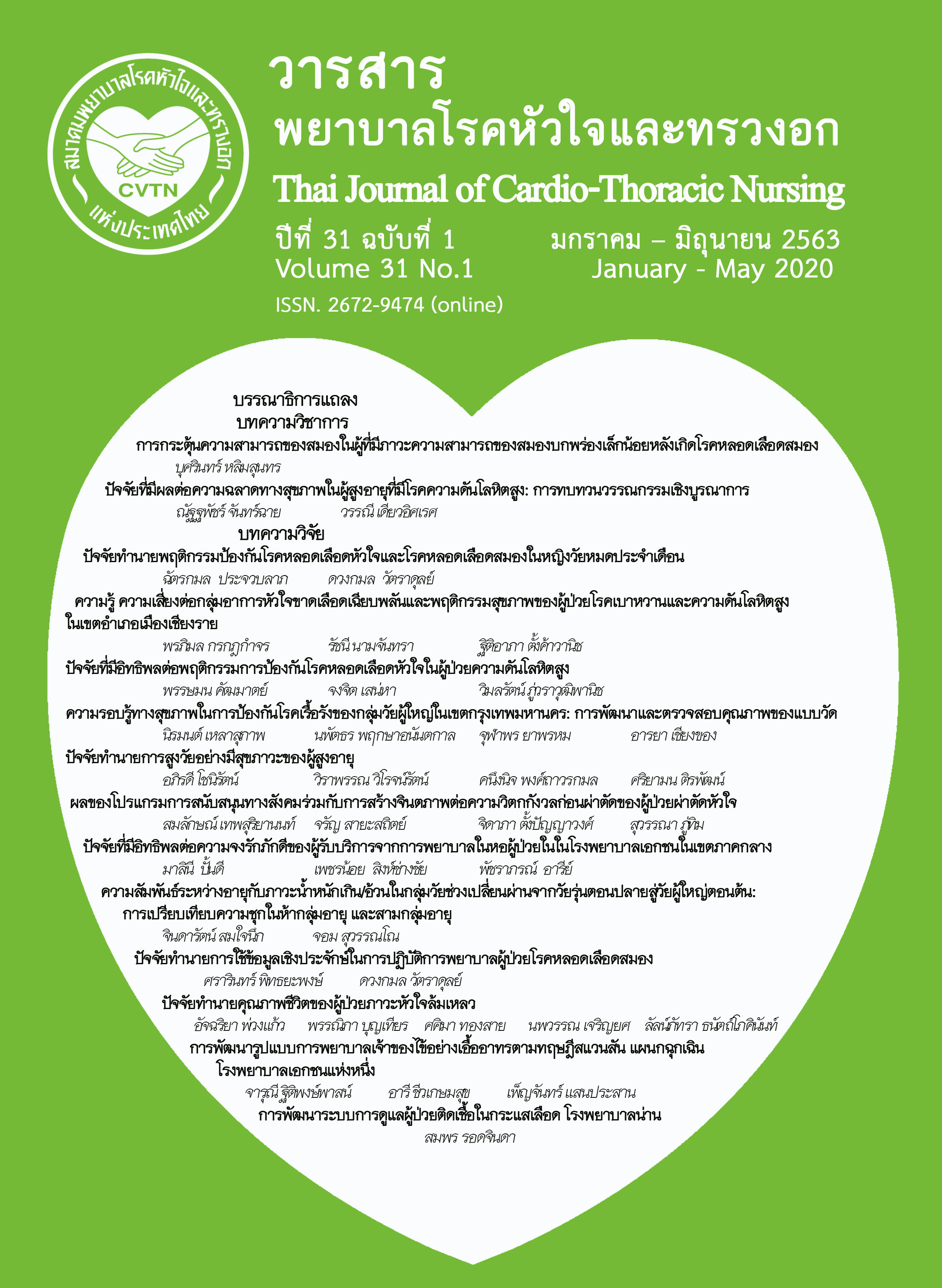ความรอบรู้ทางสุขภาพในการป้องกันโรคเรื้อรังของกลุ่มผู้ใหญ่ในเขตกรุงเทพมหานคร: การพัฒนาและตรวจสอบคุณภาพของแบบวัด
คำสำคัญ:
แบบวัดความรอบรู้ทางสุขภาพ, ความรอบรู้ทางสุขภาพของกลุ่มวัยผู้ใหญ่, โรคเรื้อรังบทคัดย่อ
ความรอบรู้ทางสุขภาพช่วยให้บุคคลสามารถป้องกันการเจ็บป่วยเรื้อรังได้อย่างมีประสิทธิภาพ การวิจัยครั้งนี้มีวัตถุประสงค์เพื่อพัฒนาและตรวจสอบคุณภาพของแบบวัดความความรอบรู้ทางสุขภาพในการป้องกันโรคเรื้อรังของกลุ่มวัยผู้ใหญ่ กลุ่มตัวอย่างเป็นวัยผู้ใหญ่ที่อาศัยในกรุงเทพมหานคร จำนวน 577 คน คัดเลือกด้วยวิธีการสุ่มตัวอย่างแบบกลุ่ม ตรวจสอบคุณภาพของแบบวัดโดยการหาความตรงด้านเนื้อหาและการวิเคราะห์องค์ประกอบเชิงยืนยัน ตรวจสอบความเชื่อมั่นด้วยวิธีหาสัมประสิทธิ์แอลฟาครอนบาค วิเคราะห์ข้อมูลโดยใช้โปรแกรมคอมพิวเตอร์ และ LISREL
ผลการวิจัยพบว่า แบบวัดความรอบรู้ทางสุขภาพในการป้องกันโรคเรื้อรังของกลุ่มวัยผู้ใหญ่ ประกอบด้วยข้อคำถาม จำนวน 17 ข้อ วิเคราะห์องค์ประกอบเชิงยืนยันพบว่า แบบจำลองการวัดมีความกลมกลืนกับข้อมูลเชิงประจักษ์ผ่านเกณฑ์ที่ยอมรับได้ (c2= 238.11, df = 105, CFI = 0.99, GFI = 0.95, AGFI = 0.93, TLI = 0.99, RMSEA = 0.047) การตรวจสอบความเที่ยงตรงเชิงเสมือนมีความเชื่อมั่นทั้งฉบับ และค่าเฉลี่ยของความแปรปรวนที่สกัดได้ (AVE) มีค่าอยู่ระหว่าง 0.474-0.571 ค่าสัมประสิทธิ์พยากรณ์และค่าสัมประสิทธิ์แอลฟาครอนบาค สูงกว่า 0.41 และ 0.914 ตามลำดับ ซึ่งแสดงถึงคุณภาพแบบวัดที่ดี
ข้อเสนอแนะ ควรนำแบบวัดความความรอบรู้ทางสุขภาพนี้ไปประเมินความรอบรู้ทางสุขภาพในการป้องกันโรคเรื้อรังของกลุ่มวัยผู้ใหญ่ เนื่องจากมีความเที่ยงตรงและมีคุณภาพเหมาะสมในการวัดความรอบรู้ทางสุขภาพในการป้องกันโรคเรื้อรัง
เอกสารอ้างอิง
2. WHO. Global status report on non-communicable diseases. Geneva: WHO Publications; 2010.
3. Kitreerawutiwong N. Chronic illness care in primary care. Journal of Public Health Nursing. 2016; 30(1): 113-26. (in Thai).
4. WHO. Global action plan for the prevention and control non-communicable diseases 2013-2020. Geneva: WHO Publications; 2013.
5. Bangkok Heath Awareness center. Preliminary report on health information for Bangkok people. Bangkok: I printing color; 2015. (in Thai).
6. Division of Non Communicable diseases. Number and mortality rate of non-communicable diseases in 2016 - 2018 per 100,000 population by province, health service area and country overview (including Bangkok). [Internet]. 2019. [cited 2019 Nov 22]. Available from: http://www.thaincd.com/ 2016/mission/ documents-detail.php?id= 13653&tid=32&gid=1-020.(in Thai).
7. Kongprasert J, Apinya T. Changing behavior guideline in quality non-communicable diseases clinic. Bangkok: The Agricultural Cooperative Federation of Thailand; 2015. (in Thai).
8. Government Information Center of Office of the Permanent Secretary Ministry of Public Health. National health development plan 12th edition 2017-2021. [Internet]. 2016 [cited 2019 Apr 20]. Available from http://wops.moph.go. th/ops/ oic/data/ 201611151447541_.pdf. (in Thai).
9. Liu Y, Liu L, Li Y, Chen, Y. Relationship between health literacy, health-related behaviors and health status: a survey of elderly Chinese. Int J Environ Res Public Health. 2015; 12(8): 9714-25.
10. WHO. Health promotion glossar. Geneva: WHO Publications; 1998.
11. Kaeodumkoeng K. Health literacy access, understand and application. Bangkok: Amarin Printing and Publishing; 2018. (in Thai).
12. Nutbeam D. The evolving concept of health literacy. Soc Sci Med. 2008;67(12):2072-78. doi:10.1016/j.socscimed.2008.09.050
13. Sørensen K, Van den Broucke S, Fullam J, et al. Health literacy and public health: a systematic review and integration of definitions and models. BMC Public Health. 2012;12:80. Published 2012 Jan 25. doi:10.1186/1471-2458-12-80
14. Intarakamhang U, Kwanchuen Y. The development and application of the ABCDE-health literacy scale for Thais. Asian Biomed. 2016; 10(6): 587–94.
15. Intarakamhang U. Creating and developing of Thailand health literacy scales. Health Education Division, Department of Health Service Support, Ministry of Public Health. 2017. (in Thai).
16. Hair JF, Black WC, Babin BJ, Anderson RE. Multivariate data analysis: a global perspective. 7th ed. Upper Saddle River, New Jersey: Prentice-Hall; 2010.
17. Polit DF, Beck CT. Nursing research: generating and assessing evidence for nursing practice. 10th ed. Philadelphia: Lippincott; 2017.
18. Stevens J. Applied multivariate statistics for the social sciences. 2nd ed. Hilldale: Erlbaum; 1992.
19. Fornell C, Larcker DF. Evaluating structural equation models with unobservable variables and measurement error. J. Mark. Res.1981; 18(1): 39-50.
20. Nunnally JC, Bernstein IH. Psychometric theory. 3rd ed. New York: McGraw-Hill; 1994.
ดาวน์โหลด
เผยแพร่แล้ว
รูปแบบการอ้างอิง
ฉบับ
ประเภทบทความ
สัญญาอนุญาต
บทความนี้ยังไม่เคยตีพิมพ์หรืออยู่ในระหว่างส่งไปตีพิมพ์ในวารสารอื่น ๆ มาก่อน และกองบรรณาธิการขอสงวนสิทธิ์ในการตรวจทาน และแก้ไขต้นฉบับตามเกณฑ์ของวารสาร ในกรณีที่เรื่องของท่านได้ได้รับการตีพิมพ์ในวารสารฉบับนี้ถือว่าเป็น ลิขสิทธิ์ของวารสารพยาบาลโรคหัวใจและทรวงอก






